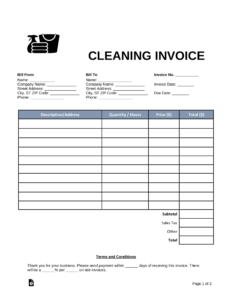Having a clean and organized office environment is essential for the productivity and well-being of employees. A clean office not only creates a positive impression on clients and visitors but also contributes to a healthier and more efficient workspace. To ensure that every nook and cranny of your office is spotless, it is crucial to have a well-defined office cleaning checklist in place. In this article, we will provide you with a comprehensive guide to creating an effective office cleaning checklist, along with valuable insights and tips to maintain a clean and healthy workplace.
The Importance of a Clean Office
A clean office is not just about aesthetics; it has a significant impact on employee health, morale, and productivity. Here are some key reasons why maintaining a clean office is crucial:
- Health and Safety: A clean office environment helps prevent the spread of germs and reduces the risk of illnesses among employees. Regular cleaning and disinfection can minimize the presence of harmful bacteria and viruses, creating a safer workplace.
- Productivity: Cluttered and dirty workspaces can be distracting and demotivating. A clean and organized office promotes focus, concentration, and efficiency, leading to increased productivity.
- Professional Image: A clean and well-maintained office creates a positive impression on clients, visitors, and potential business partners. It reflects your commitment to professionalism and attention to detail.
- Equipment Longevity: Regular cleaning and maintenance of office equipment, such as computers, printers, and HVAC systems, can extend their lifespan and reduce the need for costly repairs or replacements.
- Employee Morale: A clean and tidy office space promotes a sense of pride and well-being among employees. It enhances their overall satisfaction and happiness, leading to higher employee retention rates.
Creating an Office Cleaning Checklist
A well-designed office cleaning checklist ensures that all areas of your workplace are cleaned and maintained regularly. Here are the key steps to create an effective office cleaning checklist:
Step 1: Assess Your Office Space
The first step is to assess your office space and identify the different areas that require cleaning. Walk through each room, noting down specific cleaning tasks that need to be performed. Consider the size, layout, and usage of each area to determine the frequency and intensity of cleaning required.
Divide your office into zones, such as reception area, workstations, conference rooms, break rooms, restrooms, and common areas. This will help you organize your cleaning tasks and ensure that no area is overlooked.
Step 2: Determine Cleaning Frequencies
Once you have identified the different areas of your office, determine how often each area needs to be cleaned. Some areas may require daily cleaning, while others may only need weekly or monthly attention. Here are some general guidelines for cleaning frequencies:
- High-traffic areas, such as entrances, reception areas, and hallways, should be cleaned and maintained on a daily basis.
- Workstations, including desks, chairs, and computer peripherals, should be dusted and wiped down at least once a week.
- Restrooms should be cleaned and sanitized daily, or more frequently if necessary.
- Conference rooms and break rooms should be cleaned after each use or at least once a week.
Consider factors such as foot traffic, occupancy rates, and the nature of your business when determining cleaning frequencies.
Step 3: Identify Specific Cleaning Tasks
Next, identify the specific cleaning tasks that need to be performed for each area of your office. Break down the cleaning tasks into smaller, manageable steps to ensure that nothing is overlooked. Here are some common cleaning tasks to consider:
- Dusting and wiping down surfaces, including desks, tables, countertops, and shelves.
- Vacuuming or mopping floors, including carpets, tiles, and hardwood.
- Emptying and sanitizing trash bins.
- Cleaning and disinfecting restrooms, including toilets, sinks, mirrors, and fixtures.
- Washing windows and glass surfaces.
- Cleaning and disinfecting common areas, such as waiting areas, break rooms, and kitchenettes.
- Refilling supplies, such as hand soap, toilet paper, and paper towels.
Make sure to include any specific cleaning requirements that are unique to your office, such as the cleaning of specialized equipment or sensitive areas.
Step 4: Assign Responsibilities
Once you have defined the cleaning tasks, assign responsibilities to individuals or a professional cleaning service. Clearly communicate the cleaning expectations and provide training if necessary. Regularly review and evaluate the cleaning performance to ensure that the checklist is being followed effectively.
Best Practices for Office Cleaning
In addition to following an office cleaning checklist, implementing best practices can further enhance the cleanliness and hygiene of your workplace. Here are some valuable tips to keep your office spotless:
1. Regularly Dust and Wipe Down Surfaces
Dust and dirt can accumulate quickly on surfaces, making your office look unclean and unprofessional. Regularly dust and wipe down surfaces using appropriate cleaning solutions and microfiber cloths. Pay special attention to high-touch areas, such as doorknobs, light switches, and keyboards.
2. Use Environmentally Friendly Cleaning Products
Choose cleaning products that are eco-friendly and free from harsh chemicals. This not only promotes a healthier work environment but also reduces the impact on the environment. Look for products with eco-certifications, such as Green Seal or EcoLogo.
3. Encourage Employees to Keep Their Workspaces Clean
Employee involvement is crucial in maintaining a clean office. Encourage employees to keep their workspaces organized and clutter-free. Provide them with the necessary cleaning supplies, such as disinfectant wipes and trash bins, to promote cleanliness and personal responsibility.
4. Implement a Recycling Program
Reduce waste and promote sustainability by implementing a recycling program in your office. Place recycling bins in easily accessible areas and provide clear instructions on what can and cannot be recycled. Educate employees about the importance of recycling and the positive impact it has on the environment.
5. Schedule Deep Cleaning and Maintenance
In addition to regular cleaning tasks, schedule deep cleaning and maintenance activities to keep your office in top condition. This may include carpet cleaning, upholstery cleaning, HVAC system maintenance, and window washing. Plan these activities in advance and communicate them to employees to minimize disruption.
Conclusion
Maintaining a clean and healthy office environment is essential for the well-being and productivity of employees. By creating an office cleaning checklist and following best practices, you can ensure that your workplace remains spotless and inviting. Regular cleaning, along with employee involvement, promotes a positive work culture and reflects your commitment to professionalism. Remember, a clean office is not just a luxury but a necessity for a successful and thriving business.
FAQs
Q1: How often should I clean my office carpets?
A1: The frequency of carpet cleaning depends on several factors, such as foot traffic, carpet type, and the presence of stains or odors. In general, it is recommended to have your office carpets professionally cleaned at least once every 6 to 12 months. However, high-traffic areas may require more frequent cleaning.
Q2: Should I hire a professional cleaning service or rely on in-house cleaning staff?
A2: The decision to hire a professional cleaning service or rely on in-house cleaning staff depends on your specific needs and budget. Professional cleaning services offer expertise, specialized equipment, and flexibility, but they may come at a higher cost. In-house cleaning staff provides more control and customization options, but you need to ensure proper training and supervision.
Q3: How can I prevent the spread of germs in the office?
A3: To prevent the spread of germs in the office, encourage proper hand hygiene among employees by providing hand sanitizers and promoting frequent handwashing. Regularly clean and disinfect high-touch surfaces, such as doorknobs, light switches, and shared equipment. Implement policies for sick leave and encourage employees to stay home when they are unwell.
Q4: What should I consider when choosing cleaning products for my office?
A4: When choosing cleaning products for your office, consider factors such as effectiveness, safety, and environmental impact. Look for products that are specifically designed for commercial use and have proven efficacy against bacteria and viruses. Opt for environmentally friendly products that are free from harsh chemicals and have recognized eco-certifications.
Q5: How can I maintain a clean office during the COVID-19 pandemic?
A5: To maintain a clean office during the COVID-19 pandemic, follow the guidelines provided by health authorities, such as the Centers for Disease Control and Prevention (CDC) and the World Health Organization (WHO). Increase the frequency of cleaning and disinfection, especiallyin high-touch areas. Use EPA-approved disinfectants that are effective against COVID-19. Encourage social distancing, provide hand sanitizers, and promote proper hygiene practices among employees. Consider implementing additional measures, such as installing plexiglass barriers and improving ventilation systems, to further reduce the risk of transmission.
Summary
Maintaining a clean and healthy office environment is crucial for the well-being and productivity of employees. A clean office not only creates a positive impression but also contributes to a safer and more efficient workspace. By creating an office cleaning checklist and following best practices, you can ensure that every corner of your office is spotless. Assess your office space, determine cleaning frequencies, identify specific cleaning tasks, and assign responsibilities to maintain a clean and organized workplace. Implementing regular cleaning, encouraging employee involvement, and following eco-friendly practices are essential for maintaining a clean and healthy office. Remember, a clean office is not just a luxury but a necessity for a successful and thriving business.
FAQs
Q1: How often should I clean my office carpets?
A1: The frequency of carpet cleaning depends on several factors, such as foot traffic, carpet type, and the presence of stains or odors. In general, it is recommended to have your office carpets professionally cleaned at least once every 6 to 12 months. However, high-traffic areas may require more frequent cleaning.
Q2: Should I hire a professional cleaning service or rely on in-house cleaning staff?
A2: The decision to hire a professional cleaning service or rely on in-house cleaning staff depends on your specific needs and budget. Professional cleaning services offer expertise, specialized equipment, and flexibility, but they may come at a higher cost. In-house cleaning staff provides more control and customization options, but you need to ensure proper training and supervision.
Q3: How can I prevent the spread of germs in the office?
A3: To prevent the spread of germs in the office, encourage proper hand hygiene among employees by providing hand sanitizers and promoting frequent handwashing. Regularly clean and disinfect high-touch surfaces, such as doorknobs, light switches, and shared equipment. Implement policies for sick leave and encourage employees to stay home when they are unwell.
Q4: What should I consider when choosing cleaning products for my office?
A4: When choosing cleaning products for your office, consider factors such as effectiveness, safety, and environmental impact. Look for products that are specifically designed for commercial use and have proven efficacy against bacteria and viruses. Opt for environmentally friendly products that are free from harsh chemicals and have recognized eco-certifications.
Q5: How can I maintain a clean office during the COVID-19 pandemic?
A5: To maintain a clean office during the COVID-19 pandemic, follow the guidelines provided by health authorities, such as the Centers for Disease Control and Prevention (CDC) and the World Health Organization (WHO). Increase the frequency of cleaning and disinfection, especially in high-touch areas. Use EPA-approved disinfectants that are effective against COVID-19. Encourage social distancing, provide hand sanitizers, and promote proper hygiene practices among employees. Consider implementing additional measures, such as installing plexiglass barriers and improving ventilation systems, to further reduce the risk of transmission.





